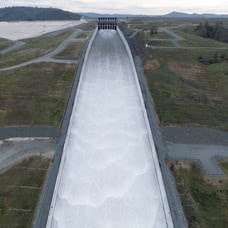 Main Spillway Releases Continue The Department of Water Resources (DWR) is continuing water releases from Lake Oroville using the main spillway and Hyatt Powerplant. During the winter months, releases from Lake Oroville provide flood protection to downstream communities by maintaining storage capacity in the reservoir for additional rain capture and future snowmelt. DWR coordinates releases closely with the U.S. Army Corps of Engineers and other water operators and adjusts releases as needed to account for continuing runoff. The information below reflects current reservoir level estimates. Forecasts can change quickly and may affect the estimates provided.
Crews may also be seen working near the main spillway for several weeks. Sections of the spillway’s underdrain system are being re-inspected to capture additional video footage. In addition, crews will be performing maintenance and repairs to the spillway’s lighting system. The Lake Oroville reservoir is the largest storage facility in the State Water Project, providing flood protection while supporting environmental and water delivery needs to 27 million Californians. In 2023, Oroville Dam’s main spillway passed over 2,370,000 acre-feet of water, 67 percent of Lake Oroville’s capacity, with flows as high as 36,000 cfs. The main spillway continues to perform well and operate as designed. DWR continues to monitor lake levels, weather forecasts, and mountain snow levels to optimize water storage while allowing for carryover storage into next year. Oroville Dam Citizens Advisory Commission The California Natural Resources Agency is hosting its 16th Oroville Dam Citizens Advisory Commission meeting Friday, March 1 from 10 a.m. to noon at the Southside Oroville Community Center located at 2959 Lower Wyandotte Road, Oroville, CA, 95966. The public meeting will include presentations and public comment. The Commission will receive briefings on the process DWR uses to prioritize and select Oroville facility projects, the forecast of expenditures for State Water Project activities at Oroville, and State emergency preparedness coordination and the use of weather forecasting in emergency response. The Citizens Advisory Commission is a forum for questions and feedback from the communities surrounding Oroville Dam. For more information about the meeting, please visit the Oroville Dam Citizens Advisory Commission website. 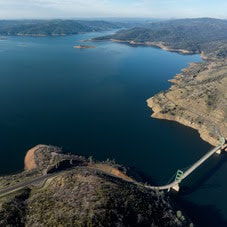 STATE WATER PROJECT ALLOCATION DWR announced on Feb. 21 an increase in the State Water Project (SWP) allocation forecast for 2024. The forecasted allocation is now 15 percent of requested supplies, up from the 10 percent initial allocation announced in December. This translates to about 200,000 acre-feet of additional water for the 29 public water agencies that serve 27 million Californians. This assessment does not include the results of any of the storms that hit California earlier this month. The State Water Project will review conditions and may revise the forecasted allocation in mid-March. The February allocation forecast update takes into account snow survey measurements and data up until Feb.1 and spring runoff forecasts outlined in the first Bulletin 120 of the season. More information about the allocation announcement is available in DWR’s press release. 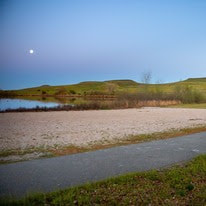 OROVILLE RECREATION DWR, the California Department of Parks and Recreation (State Parks), and the California Department of Fish and Wildlife (CDFW) maintain over 92 miles of trails in the Oroville area. An interactive map of recreation facilities, including open trails and their permitted uses (hike, bike, horse, multi), is available on DWR’s Lake Oroville Recreation webpage. A paper trail map is available at various locations, including most entrance kiosks and the Lake Oroville Visitor Center. The Lake Oroville Visitor Center is open daily from 9 a.m. to 5 p.m. Staffed by knowledgeable guides, the Visitor Center features interpretive displays on Oroville Dam, area geology, wildlife and habitat, hydroelectric power, and cultural and historical artifacts. View videos in the theater about the construction of Oroville Dam, walk or hike along nearby trails, and visit the 47-foot-tall observation tower that provides unsurpassed panoramic views of surrounding areas. Free guided tours for school and community groups are available by reservation. Parking and admission to the Visitor Center are free. Lake Oroville is one of the State Water Project’s premier recreational destinations and one of California’s best fishing spots. The lake provides both warm-water and cold-water fisheries and is a popular destination for bass tournaments. Below the Oroville Dam, the Thermalito Afterbay and the Feather River offer additional excellent fishing opportunities. The marinas at Bidwell Canyon and Lime Saddle are open daily and provide a variety of services including a convenience store, gas, and boat rentals. Upstream migrating fish totals between Jan. 1 and Feb. 18 are:
Feather River flows remain at 650 cfs through the City of Oroville with 9,350 cfs being released from the Thermalito Afterbay River Outlet (Outlet) for a total Feather River release of 10,000 cfs downstream. DWR continues to assess releases to the Feather River daily. Visitors to Oroville Dam may also notice minor amounts of water flowing from drains built into the emergency spillway, which is normal and expected with the emergency spillway design. The dam and emergency spillway continue to operate as intended. The public can track precipitation, snow, reservoir levels, and more at the California Data Exchange Center. The Lake Oroville gage station is identified as “ORO.” All data as of midnight 2/22/2024. 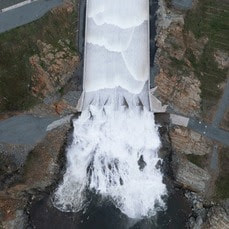 Main Spillway Releases Resume The Department of Water Resources (DWR) increased water releases from Lake Oroville this week in advance of a series of storms. Water releases from Oroville Dam’s main spillway also resumed around 10 a.m. today with continuing releases through the Hyatt Powerplant. During the winter months, releases from Lake Oroville provide flood protection to downstream communities by maintaining storage capacity in the reservoir for additional rain capture. DWR coordinates releases closely with the U.S. Army Corps of Engineers and other water operators and adjusts releases as needed to account for continuing runoff. The information below reflects current reservoir level estimates. Forecasts can change quickly and may affect the estimates provided.
Crews may also be seen working near the main spillway for several weeks. Sections of the spillway’s underdrain system are being re-inspected to capture additional video footage. In addition, crews will be performing maintenance and repairs to the spillway’s lighting system. The Lake Oroville reservoir is the largest storage facility in the State Water Project, providing flood protection while supporting environmental and water delivery needs to 27 million Californians. In 2023, Oroville Dam’s main spillway passed over 2,370,000 acre-feet of water, 67 percent of Lake Oroville’s capacity, with flows as high as 36,000 cfs. The main spillway continues to perform well and operate as designed. DWR continues to monitor lake levels, weather forecasts, and mountain snow levels to optimize water storage while allowing for carryover storage into next year. Temporary Bathroom Closure Extended DWR is alerting Oroville Dam recreation users to extended temporary closures of the Oroville Dam Overlook and Spillway Day-Use Area restrooms for sewer system work. Due to material delays, the bathrooms are expected to remain closed through the week of Feb. 18 with closures possibly extending into the following week. DWR has placed portable toilets and hand washing stations at these locations to continue to provide restroom facilities. 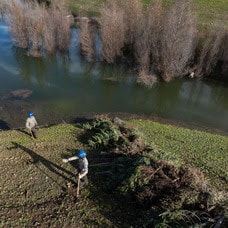 CHRISTMAS TREE HABITAT CONSTRUCTION DWR, the California Conservation Corps (CCC), and the Department of Fish and Wildlife (CDFW) finished constructing fish habitat structures at Lake Oroville and the Thermalito Afterbay using just over 1,000 recycled Christmas trees. The trees were again collected by Chico Boy Scout Troop 2 and delivered free of charge to the Oroville facilities by Recology, a local waste management company. To create the habitat structures at Lake Oroville and the Thermalito Afterbay, members of the CCC team bundle the recycled holiday trees together and anchor them in various locations around the lakebed. At Lake Oroville near the Saddle Dam Recreation Area, 625 trees were assembled into 29 structures. At the Thermalito Afterbay, 426 trees were assembled into 42 structures. Anchoring the trees allows them to remain submerged when the water levels rise, providing juvenile fish safe refuge and improving fish populations. When water levels drop the structures then provide habitat for native animals. This marks the 30th year that DWR has worked with local groups to construct fish habitat structures, making it one of the longest continuously running warmwater fish habitat improvement programs in the State of California. 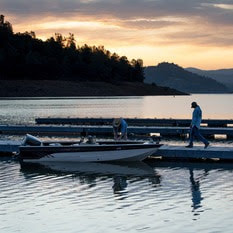 OROVILLE RECREATION The Lake Oroville Visitor Center is open daily from 9 a.m. to 5 p.m. Staffed by knowledgeable guides, the Visitor Center features interpretive displays on Oroville Dam, area geology, wildlife and habitat, hydroelectric power, and cultural and historical artifacts. View videos in the theater about the construction of Oroville Dam, walk or hike along nearby trails, and visit the 47-foot-tall observation tower that provides unsurpassed panoramic views of surrounding areas. Free guided tours for school and community groups are available by reservation. Parking and admission to the Visitor Center are free. Lake Oroville is one of the State Water Project’s premier recreational destinations and one of California’s best fishing spots. The lake provides both warm-water and cold-water fisheries and is a popular destination for bass tournaments. Below the Oroville Dam, the Thermalito Afterbay and the Feather River offer additional excellent fishing opportunities. The marinas at Bidwell Canyon and Lime Saddle are open daily and provide a variety of services including a convenience store, gas, and boat rentals. Upstream migrating fish totals between Sept. 11, 2023 and Feb. 10, 2024 are:
CURRENT LAKE OPERATIONS Lake Oroville is at 850 feet elevation and storage is approximately 2.81 million acre-feet (MAF), which is 79 percent of its total capacity and 131 percent of the historical average. Feather River flows remain at 650 cfs through the City of Oroville with 7,350 cfs being released from the Thermalito Afterbay River Outlet (Outlet) for a total Feather River release of 8,000 cfs downstream. DWR continues to assess releases to the Feather River daily. Visitors to Oroville Dam may also notice minor amounts of water flowing from drains built into the emergency spillway, which is normal and expected with the emergency spillway design. The dam and emergency spillway continue to operate as intended. The public can track precipitation, snow, reservoir levels, and more at the California Data Exchange Center. The Lake Oroville gage station is identified as “ORO.” All data as of midnight 2/15/2024. 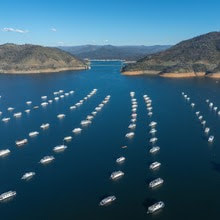 Main Spillway Releases End The Department of Water Resources (DWR) stopped water releases from Oroville Dam’s main spillway at 10 a.m. on Feb. 7 due to low inflow into Lake Oroville. Water releases are still being made through the Hyatt Powerplant to provide flood protection to downstream communities during the winter storm season. DWR coordinates releases closely with the U.S. Army Corps of Engineers and other water operators and adjusts releases as needed to account for continuing runoff. Visitors to Oroville Dam may still see water on the main spillway even when the radial gates are closed as they are not designed to be watertight. The seals do not play a role in the structural integrity of the gates, which continue to operate as intended. DWR periodically maintains and adjusts the seals during low-reservoir conditions to improve their sealing capability. Total releases to the Feather River amount to 3,000 cubic feet per second with 650 cfs being routed down the low-flow channel through the City of Oroville. An additional 2,350 cfs is being released from the Thermalito Afterbay River Outlet, located 5 miles downstream from Oroville. Feather River releases may increase again in the future to account for additional incoming storms and high inflows. Feather River recreation users are advised to remain alert as river flows are expected to be swift and cold and may change based on projected weather forecasts. Starting this week, crews may also be seen working near the main spillway. Sections of the spillway’s underdrain system are being re-inspected to capture additional video footage. In addition, crews will be performing maintenance and repairs to the spillway’s lighting system. The Lake Oroville reservoir is the largest storage facility in the State Water Project, providing flood protection while supporting environmental and water delivery needs to 27 million Californians. In 2023, Oroville Dam’s main spillway passed over 2,370,000 acre-feet of water, 67 percent of Lake Oroville’s capacity, with flows as high as 36,000 cfs. The main spillway continues to perform well and operate as designed. DWR continues to monitor lake levels, weather forecasts, and mountain snow levels to optimize water storage while allowing for carryover storage into next year. Temporary Bathroom Closure DWR is alerting Oroville Dam recreation users to temporary closures of the Oroville Dam Overlook and Spillway Day-Use Area restrooms for sewer system work. The bathrooms will close starting Monday, Feb. 12 and are expected to remain closed for the duration of repairs, approximately one week. During the work, DWR will place portable toilets and hand washing stations at these locations to continue to provide restroom facilities. 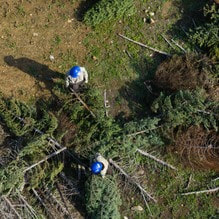 CHRISTMAS TREE HABITAT CONSTRUCTION DWR, the California Conservation Corps (CCC), and the Department of Fish and Wildlife (CDFW) finished constructing fish habitat structures at Lake Oroville and the Thermalito Afterbay using just over 1,000 recycled Christmas trees. The trees were again collected by Chico Boy Scout Troop 2 and delivered free of charge to the Oroville facilities by Recology, a local waste management company. To create the habitat structures at Lake Oroville and the Thermalito Afterbay, members of the CCC team bundle the recycled holiday trees together and anchor them in various locations around the lakebed. At Lake Oroville near the Saddle Dam Recreation Area, 625 trees were assembled into 29 structures. At the Thermalito Afterbay, 426 trees were assembled into 42 structures. Anchoring the trees allows them to remain submerged when the water levels rise, providing juvenile fish safe refuge and improving fish populations. When water levels drop the structures then provide habitat for native animals. This marks the 30th year that DWR has worked with local groups to construct fish habitat structures, making it one of the longest continuously running warmwater fish habitat improvement programs in the State of California. 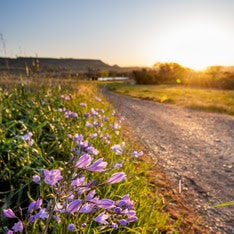 OROVILLE RECREATION DWR, State Parks, and the California Department of Fish and Wildlife (CDFW) maintain over 92 miles of trails in the Oroville area. An interactive map of recreation facilities, including open trails and their permitted uses (hike, bike, horse, multi), is available on DWR’s Lake Oroville Recreation webpage. A paper trail map is available at various locations, including most entrance kiosks and the Lake Oroville Visitor Center. The Lake Oroville Visitor Center is open daily from 9 a.m. to 5 p.m. Staffed by knowledgeable guides, the Visitor Center features interpretive displays on Oroville Dam, area geology, wildlife and habitat, hydroelectric power, and cultural and historical artifacts. View videos in the theater about the construction of Oroville Dam, walk or hike along nearby trails, and visit the 47-foot-tall observation tower that provides unsurpassed panoramic views of surrounding areas. Free guided tours for school and community groups are available by reservation. Parking and admission to the Visitor Center are free. Lake Oroville is one of the State Water Project’s premier recreational destinations and one of California’s best fishing spots. The lake provides both warm-water and cold-water fisheries and is a popular destination for bass tournaments. Below the Oroville Dam, the Thermalito Afterbay and the Feather River offer additional excellent fishing opportunities. The marinas at Bidwell Canyon and Lime Saddle are open daily and provide a variety of services including a convenience store, gas, and boat rentals. Upstream migrating fish totals between Sept. 11, 2023 and Jan. 27, 2024 are:
CURRENT LAKE OPERATIONS Lake Oroville is at 845 feet elevation and storage is approximately 2.75 million acre-feet (MAF), which is 78 percent of its total capacity and 131 percent of the historical average. Feather River flows remain at 650 cfs through the City of Oroville with 2,350 cfs being released from the Thermalito Afterbay River Outlet (Outlet) for a total Feather River release of 3,000 cfs downstream. DWR continues to assess releases to the Feather River daily. Visitors to Oroville Dam may also notice minor amounts of water flowing from drains built into the emergency spillway, which is normal and expected with the emergency spillway design. The dam and emergency spillway continue to operate as intended. The public can track precipitation, snow, reservoir levels, and more at the California Data Exchange Center. The Lake Oroville gage station is identified as “ORO.” All data as of midnight 2/8/2024. 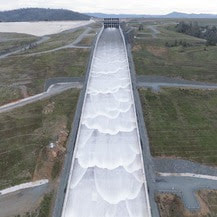 Spillway Releases Begin at Oroville Dam The Department of Water Resources (DWR) began releasing water from Oroville Dam’s main spillway on Jan. 31. Ongoing releases to the Feather River ensure storage space remains in Lake Oroville for flood control protection to downstream communities. DWR coordinates releases closely with the U.S. Army Corps of Engineers and other water operators and adjusts releases as needed to account for continuing rain. The information below reflects current reservoir level estimates. Forecasts can change quickly and may affect the estimates provided.
Starting the week of Feb. 5, crews may also be seen working near the main spillway. Sections of the spillway’s underdrain system are being re-inspected to capture additional video footage. In addition, crews will be performing maintenance and repairs to the spillway’s lighting system. The Lake Oroville reservoir is the largest storage facility in the State Water Project, providing flood protection while supporting environmental and water delivery needs to 27 million Californians. In 2023, Oroville Dam’s main spillway passed over 2,370,000 acre-feet of water, 67 percent of Lake Oroville’s capacity, with flows as high as 36,000 cfs. The main spillway continues to perform well and operate as designed. DWR continues to monitor lake levels, weather forecasts, and mountain snow levels to optimize water storage while allowing for carryover storage into next year. Oroville Recreation Advisory Committee The Oroville Recreation Advisory Committee (ORAC) met Feb. 2 at the Southside Oroville Community Center. ORAC was established by the Federal Energy Regulatory Commission (FERC) to review and provide recreation plan recommendations for Oroville Facilities owned by DWR. The 13-member committee is made up of representatives from state and local government, recreation groups, and business and community organizations. To obtain a summary of the meeting, send a request to [email protected]. 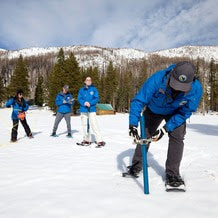 FEBRUARY SNOW SURVEY DWR conducted the second snow survey of the season at Phillips Station on Jan. 30. The manual survey recorded 29 inches of snow depth and a snow water equivalent of 10 inches, which is 58 percent of average for this location. The snow water equivalent measures the amount of water contained in the snowpack and is a key component of DWR’s water supply forecast. The results reflect a modest increase in the snowpack since Jan. 1, but overall conditions are still far below normal. DWR’s electronic readings from 130 stations placed throughout the state indicate that the statewide snowpack’s snow water equivalent is 8.4 inches, or 52 percent of average for this date, an improvement from just 28 percent of average on Jan. 1. One year ago, the snowpack statewide was 214 percent of average on Feb. 1. Despite additional precipitation in January, many storms so far this year have been warmer than average, producing rain rather than snow at higher elevations. Overall statewide precipitation is 82 percent of average for this date. Last year’s snowpack was aided by both above average precipitation and below average temperatures, which created a historic snowpack and improved reservoir storage statewide, which is still above average. Lake Oroville, the State Water Project’s largest reservoir, is currently 131 percent of average. More information about the recent snow survey can be found in DWR’s press release. 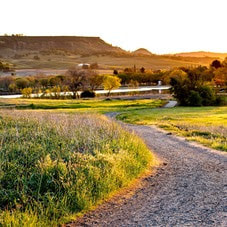 OROVILLE RECREATION DWR, State Parks, and the California Department of Fish and Wildlife (CDFW) maintain over 92 miles of trails in the Oroville area. An interactive map of recreation facilities, including open trails and their permitted uses (hike, bike, horse, multi), is available on DWR’s Lake Oroville Recreation webpage. A paper trail map is available at various locations, including most entrance kiosks and the Lake Oroville Visitor Center. The Lake Oroville Visitor Center is open daily from 9 a.m. to 5 p.m. Staffed by knowledgeable guides, the Visitor Center features interpretive displays on Oroville Dam, area geology, wildlife and habitat, hydroelectric power, and cultural and historical artifacts. View videos in the theater about the construction of Oroville Dam, walk or hike along nearby trails, and visit the 47-foot-tall observation tower that provides unsurpassed panoramic views of surrounding areas. Free guided tours for school and community groups are available by reservation. Parking and admission to the Visitor Center are free. Lake Oroville is one of the State Water Project’s premier recreational destinations and one of California’s best fishing spots. The lake provides both warm-water and cold-water fisheries and is a popular destination for bass tournaments. Below the Oroville Dam, the Thermalito Afterbay and the Feather River offer additional excellent fishing opportunities. The marinas at Bidwell Canyon and Lime Saddle are open daily and provide a variety of services including a convenience store, gas, and boat rentals. Upstream migrating fish totals between Sept. 11, 2023 and Jan. 27, 2024 are:
CURRENT LAKE OPERATIONS Lake Oroville is at 842 feet elevation and storage is approximately 2.7 million acre-feet (MAF), which is 76 percent of its total capacity and 131 percent of the historical average. Feather River flows remain at 650 cfs through the City of Oroville with 9,350 cfs being released from the Thermalito Afterbay River Outlet (Outlet) for a total Feather River release of 10,000 cfs downstream. DWR continues to assess releases to the Feather River daily. Visitors to Oroville Dam may also notice minor amounts of water flowing from drains built into the emergency spillway, which is normal and expected with the emergency spillway design. The dam and emergency spillway continue to operate as intended. The public can track precipitation, snow, reservoir levels, and more at the California Data Exchange Center. The Lake Oroville gage station is identified as “ORO.” All data as of midnight 2/1/2024. |
Archives
May 2024
Categories
All
|

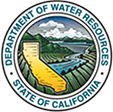
 RSS Feed
RSS Feed